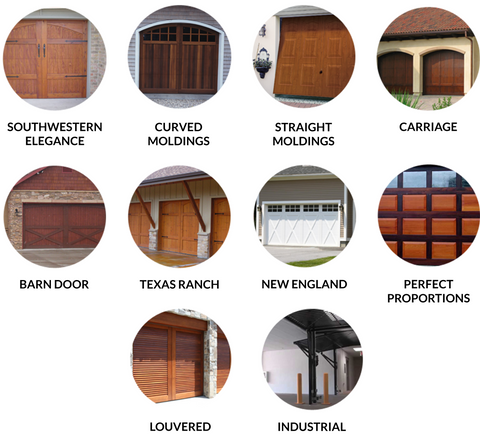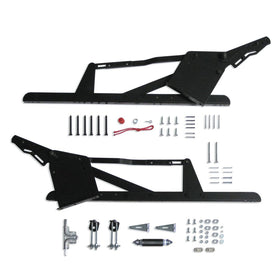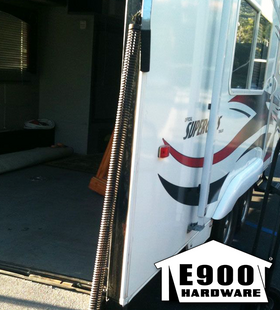
Millions of one piece, jamb mounted garage doors have been installed and are operational across the USA, especially in the western regions. One piece garage doors are advantageous because they are easy to install, take up less headroom in the garage and can fit in tighter spaces than sectional doors.
Field installation and adjustment is fast and simple, largely because the door is one piece. The door sits straight up in the opening during installation and no ladders are required. The springs (and everything else) are put in place while the installer has his feet on the ground!
DOOR CONSTRUCTION
A major benefit of one-piece type garage doors is the ability to maintain architectural integrity in the construction of the garage and garage door. In addition, the one piece style allows for more involved designs on the door facade compared to sectional doors. Some of the more popular design styles are listed below:

CONSTRUCTION GUIDELINES
MAXIMUM DOOR WEIGHTS AND SIZES
For doors weighing up to 200 pounds and measuring between 6'-10" and 7'-4" tall. Light duty hardware is generally used on single car garage doors up to 10' wide, but it is also used on up to 16' wide aluminum and lightweight steel doors.
For doors weighing up to 325 pounds and measuring between 6'-10" and 7'-4" tall. Medium duty hardware is generally used on double car garage doors up to 16' wide. Wood doors wider than 10' are required to have added stiffening supports, such as truss rods, to prevent the door from sagging while in the open position. Medium duty hardware is also available with a heavy-duty main pivot for longer cycle life.
For doors weighing up to 350 pounds and measuring between 6'-10" and 7'-4" tall. Heavy-duty hardware is generally used on double car garage doors up to 16" wide. Wood doors wider than 10' are required to have added stiffening supports, such as truss rods, to prevent the door from sagging while in the open position.
Jamb type hardware is available for special residential applications such as:
- Hardware designed with a smoother operation for use with electric openers
- Hardware designed for installations that require the door to be flush to the exterior surface of the garage (a.k.a. flush hang)
- Heavy duty hardware (commercial grade) for doors exceeding the height and weight capacity of residential hardware
For doors weighing up to 300 pounds and measuring between 6'-6" and 7'-8" tall. This hardware is generally used on doors up to 16' wide. Wood doors wider than 10' are required to have added stiffening supports, such as truss rods, to prevent the door from sagging while in the open position.
WOOD GARAGE DOOR WEIGHT CALCULATION DATA SHEET

BENEFITS OF JAMB TYPE HARDWARE
Fewer components to install compared to sectional doors or jamb type with track, resulting in less installation time.
Less interference with beams and floor joists since the door remains halfway inside/outside the garage while open.
As little as 1-1/2" headroom required to open and close the garage door, maximizing space usage.
Smoother operation with electric garage door openers when compared to jamb type with track.
Wide selection of jamb type hardware available, accommodating door heights from 6'-4" to 12'-5", and door weights from 200 to 450 pounds.
Quieter operation than typical sectional doors because of less moving parts.
Less costly compared with installations using sectional doors or jamb type hardware with tracks.
Allows for more eloquent door designs, as the door can remain in one piece versus being divided into sections.
MAJOR COMPONENT PARTS OF ONE-PIECE JAMB TYPE

- Master Plate: for attachment to the door jamb.
- Master Arm: the main load-carrying member.
- Door Angle: for attachment to the door.
- Kicker Assembly: for the attachment of springs to the master arm, for adjustment of spring tension, and, by using the bolt in the slot, for adjustment of spring force in the last 1/4 of door travel.
- Spring Connector Assembly: for the attachment of springs to the kicker and to the chain or lower jamb connector. Also serves to contain the spring if the spring breaks.
- Cantilever Arms: for adjusting the vertical position and angle of the door when in the closed position.
- Extension Springs: for counter balancing the weight of the door.
- Spring Anchor Chain: for attachment of springs to the jamb.
- Lower Jamb Connector: another method for attachment of springs to the jamb. Makes it easier to install and adjust the tension on the springs.
- Fasteners: including pivot points which hold hinge components together, bolts which are used to adjust headroom, spring tension, etc., and mounting hardware.
- Main Pivot: the pivot point connecting the master arm to the master plate.


